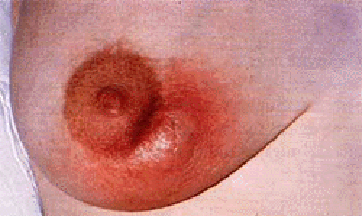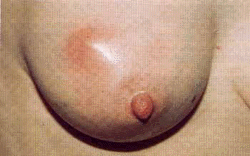History and exam
Key diagnostic factors
common
fever
Mastitis may occur with or without pyrexia >38°C (>100.4°F).
Breast abscess may or may not be accompanied by fever.[1]
decreased milk outflow
Milk stasis may be associated with the development of mastitis.[1]
breast warmth
Tactile breast warmth is suggestive of mastitis and a possible underlying abscess.[1]
Lactational mastitis tends to involve more peripheral wedge-shaped areas.
breast tenderness
Breast tenderness is suggestive of mastitis and/or abscess.[1]
Lactational mastitis tends to involve more peripheral wedge-shaped areas.
breast firmness
Breast firmness can be suggestive of mastitis and a possible underlying abscess when accompanied by other signs of mastitis.[1]
Lactational mastitis tends to involve more peripheral wedge-shaped areas.
breast swelling
Breast swelling can be suggestive of mastitis and/or abscess when accompanied by other signs of mastitis.[1]
Lactational mastitis tends to involve more peripheral wedge-shaped areas.
Swelling may indicate skin oedema and/or underlying abscess formation.
breast erythema
Redness of the skin of the breast (erythema) can be suggestive of mastitis and a possible underlying abscess.[1][Figure caption and citation for the preceding image starts]: Non-lactating breast abscess due to peri-ductal mastitisFrom the collection of Mr R. Vashisht, West Middlesex University Hospital, London; used with permission [Citation ends].
Lactational mastitis tends to involve more peripheral wedge-shaped areas.[Figure caption and citation for the preceding image starts]: A breast abscess that developed during breastfeedingFrom the collection of Mr R. Vashisht, West Middlesex University Hospital, London; used with permission [Citation ends].
flu-like symptoms, malaise, and myalgia
Patients with mastitis and/or breast abscess may complain of systemic symptoms.[1]
breast pain
Usually sharp, shooting, or throbbing breast pain, especially with breastfeeding, may indicate mastitis.[1]
uncommon
Other diagnostic factors
uncommon
nipple discharge
May occur with or without mastitis.
Often associated with duct ectasia (dilated breast duct associated with inflammation).
Purulent discharge is usually indicative of infection.
nipple inversion/retraction
Infrequently seen with mastitis.
lymphadenopathy
Tender axillary lymph nodes may occur with ipsilateral breast infection.
extra-mammary skin lesions
Patients with mastitis and/or breast abscess may present with systemic signs including extra-mammary skin lesions.
Risk factors
strong
female sex
Breast infection more frequently involves the female breast.
Inflammation of the male breast may occur but is unusual.
poor breastfeeding technique
Poor breastfeeding positioning, or oral infection, tongue-tie, a skin infection, and nappy rash in the infant may be associated with the development of lactational mastitis.
lactation
Lactational mastitis is more common at 6-8 weeks of breastfeeding or at weaning.[5] Mastitis is uncommon during pregnancy itself.
milk stasis
Milk stasis is associated with infectious (lactational) and non-infectious mastitis.
Milk stasis is may result from inadequate drainage, blocked ducts, milk oversupply, external pressure on the breast (e.g., tight-fitting bra), infrequent feeding, or rapid weaning.[1]
nipple injury
Nipple cracks and fissures permit bacteria to gain entry into the breast.[2]
Injury may occur when an older teething baby bites a nipple or from use of a breast pump that generates excessive vacuum.
previous mastitis
Women who have had mastitis have an increased rate of recurrence with subsequent births.[2]
prolonged mastitis (breast abscess)
Prolonged mastitis may be associated with breast abscess formation.
women aged >30 years (breast abscess)
Women aged >30 years have a higher risk of breast abscess.[21]
prior breast abscess (breast abscess)
There is a high rate of recurrence with a remote history of prior breast abscesses.
shaving or plucking areola hair
Pulling hair from the areola may cause a Montgomery follicle abscess with potential for more widespread infection.
anatomical breast defect, mammoplasty, or scar
Altered duct structure may interfere with milk flow and predispose to mastitis.
other underlying breast condition
Particularly breast cancer.
nipple piercing
foreign body
Silicone and breast implants may cause mastitis with or without infection.[23]
Silicone mastitis may cause a hard, tender, erythematous breast mass.
skin infection
Dermatoses, such as psoriasis or eczema, may cause nipple fissures that result in recurrent mastitis.
Afflicted women are also more likely to harbour Staphylococcus aureus.
Staphylococcus aureus carrier
The vast majority of cases of infectious mastitis and breast abscess are caused by S aureus. Some studies have found that women who carry S aureus on the nipple, or have S aureus present in milk, are more likely to have lactational mastitis.[2]
weak
hospital admission
Epidemic (hospital-acquired) puerperal mastitis should be considered in any patient with signs of breast infection during or after a hospital admission.
breast trauma
Trauma to the breast may infrequently result in inflammation.
Domestic violence in such cases should always be considered.[1]
primiparity (breast abscess)
Found to be a risk factor for breast abscess in one population-based study.[21]
multiparity
Multiparity has been associated with increased risk of lactational mastitis.[2]
overabundant milk supply
For example, as may occur with lactation for twins or higher multiples.
May predispose to milk stasis.[1]
complications of delivery
May increase the risk of lactational mastitis.[1]
maternal stress
Maternal stress has been associated with lactational mastitis.[2]
tight clothing
antifungal nipple cream
fibrocystic breast disease
Fibrocystic breast disease may interfere with milk flow.
cigarette smoking
vaginal manipulation (breast abscess)
Resulting transient bacteraemia is believed to be associated with anaerobic breast abscess formation.[28]
antiretroviral therapy
In HIV-infected breastfeeding women, mastitis or breast inflammation is a possible adverse effect of maternal prophylactic HIV antiretroviral therapy, and of infant nevirapine prophylaxis.[29]
Use of this content is subject to our disclaimer